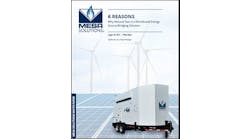An electric vehicle advocacy organization is sounding an alarm about utility market dominance over EV charging, as California’s largest utility attempts to grow its services.
Pacific Gas & Electric’s (PG&E) wants to expand its EV charging in northern California. But the Electric Vehicle Charging Association (EVCA) warns that the utility could block competition and control EV pricing.
EVs are expected to be included in microgrids in the future, and there’s much controversy over utility proposals to control charging.
A lot is at stake. PG&E is a hot spot for EV use. One in five EVs in the U.S. — more than 81,000 EVs — are registered in the utility’s service area, according to PG&E.
“Northern California is home to the most robust and competitive charging market in the world,” said Damon Conklin, an EVCA spokesman. The organization aims to ensure the region stays competitive and promotes innovation.
The controversy stems from a settlement agreement the company proposed before the California Public Utilities Commission asking for broad control of EV charging in the northern part of the state, Conklin said.
“We have significant concerns with the proposal, specifically with high costs, the size of the program, and the design of the program,” he said.
Among EVCA’s complaints: The proposal says that for the 200 fast charging stations in their territory, there will be no customer choice, Conklin said. “They will select a single vendor and not allow the site host any choice in equipment,” he said. For Level 2 stations, customer choice would be limited.
PG&E also wants to control pricing to drivers, he said.
“Investor-owned utilities should not be in the position of dictating what the prices will be,” he said. “Now, there are a range of options, and there’s no ‘One price fits all,'” he said.
In Oregon, for example, EV drivers have the option of charging at stations owned by a number of vendors, and there are a number of pricing options, ranging from free to 39 cents/kWh or more. In some cases, the driver pays the charging station owner; for at-home charges, the driver pays the utility.
Essentially, PG&E is saying “we want to own the entire market on the backs of ratepayers with no choice and no competition,” Conklin said.
PG&E has a different view.
“PG&E is committed to increasing adoption of clean and efficient EVs in California and expanding the use of EVs critical to meeting California’s ambitious zero-emission vehicles goals. A robust charging infrastructure is necessary to make that happen,” said Donald Cutler, spokesman.
He said that the company has adopted “virtually all of the conditions” related to competition, site-specific host choice and participant payments that ChargePoint and others requested.
The PG&E proposal calls for the company to install 7,500 Level 2 chargers and 100 DC Fast Chargers. The maximum impact on the average customer would be about $2.64 per year, PG&E said.
“Charging infrastructure in California will reduce range anxiety for current EV owners, and also opens up the possibility of EV ownership to those who previously wouldn’t have been able to consider an EV,” said PG&E’s Cutler. “We believe that by jump-starting the market in this way, we can spur more EV sales, put new momentum behind growth in charging infrastructure, and create more opportunity for everyone.”
Demand response with EVs
Meanwhile, the utility also recently initiated a pilot program with BMW that will examine demand response with EVs.
In the pilot, 100 BMW i3 EV customers in San Francisco help PG&E manage power demand in one of three ways, said Ari Vanrenen, a company spokeswoman.
In the first option, when PG&E calls a demand response event, BMW provides energy storage through a second-life battery system built from old BMW mini EVs.
Second, customers will respond to demand response events using smart charging with the BMW i3 EVs. “We’re testing how customers respond to demand response events,” said Vanrenen.
In the third option, the company is testing both exporting energy from the second-life battery system and smart charging.
“Through the program, we hope to evaluate how automakers, customer-owned EVs and second life batteries can support the grid through demand response,” she said.
About 400 i3 owners applied to take part in the program, and 100 were selected. They’re allowing for a delay of up to one hour in charging their vehicles when grid loads are at their peak.
“One thing that we’ll be investigating with this pilot is understanding how people charge, how flexible they are with respect to when they charge, and how best to design future products in way that benefits both customers and utilities,” said a BMW press release.
The goal of the pilot program is to provide PG&E with up to 100 kW of capacity at any given time.
For each event the EV owners will receive a text message notifying them that their vehicle charging will be halted for up to one hour. Using the BMW iChargeForward smartphone app, participants can choose to opt out of any requests, based on their driving needs. The drivers receive an incentive payment of $1,000 initially, plus up to $540 at the end of the 18-month program, based on their participation.
Who will control EV charging is just one of the many issues being sorted out as the electric grid transforms. Learn more by subscribing to the Microgrid Knowledge newsletter. It’s free.







